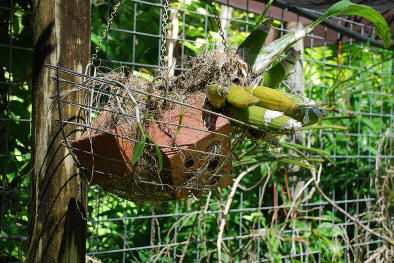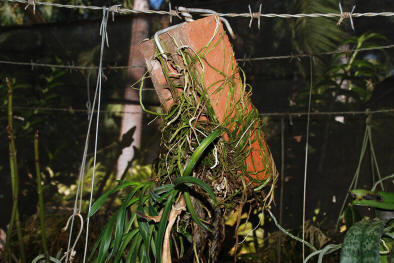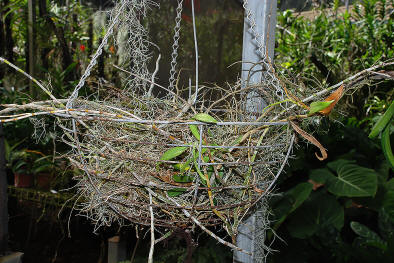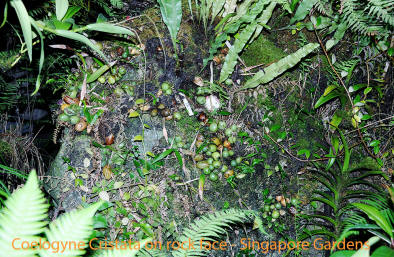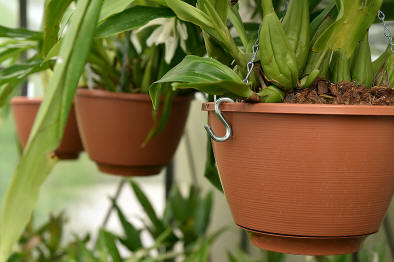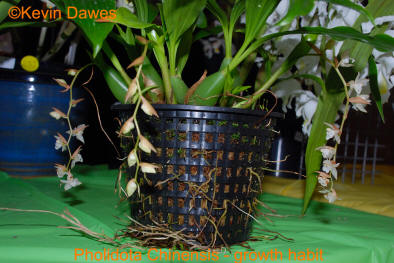I have started this section with two thought provoking images because media is a subject that holds every record possible for rubbish un-substantiated conversations and theories. In the right conditions e.g. the tropics, an orchid will grow without any media or minimal media as long as it gets plenty of water and air and something on which to steady itself. The further we move towards temperate zones the more we have to compromise in providing these three basics. Nothing else matters
Above are two more images that highlight the three basic requirements. On the left is Coelogyne cristata growing on a rock face. It has moisture, air and a home. The orchid on the right also has these three basics. In nature the plants aren't always lucky enough to have the three basics 100% of the time and like all plants in nature will go through some tough times. They have managed to survive for millions of years until a human comes along and drowns them or suffocates them - or both within a few months!
A good media is one that keeps these qualities without adding extra problems like breaking down to form air-less swamp zones or chemically poisonous, anaerobic fungus ridden zones. The longer your chosen media can continue to provide the three basics the better it is. There are many choices.
Pine bark chips were used for many years and still are by a lot of growers. They are cheap and readily available. They absorb and hold a lot of moisture and if the chips are large, they provide a lot of air space. They are fairly durable and will generally last around two years before they start decomposing. At this point the air spaces start filling up with fine rotting particles and the plant gets less and less happy. Not only are the air spaces disappearing but the nice free drainage is changing to a sour waterlogged state. Sometime during the next few months you will possibly need to repot. It's time to tip the plant out of its pot every few months and have an inspection. Rotting soil will become very obvious and also the smell will get less attractive.
Coarse coconut husk provides the three basics and takes a little bit longer to start decomposing and causing the same problems. Eventually, it will need replacing. It could also be considered as recycling a commercially used product.
Spaghnum moss is good for little plants and seedlings because with tiny plants everything needs to be scaled down to cope with their tiny roots. They need tiny air spaces and don't need to have their tiny roots lost in between relatively big chunks of the above media. Moss holds masses of moisture for long periods and if it is really loosely packed it holds lots of air space. It can be tricky to manage because it is a growing plant itself. It needs its correct amount of moisture and correct amount of air spaces or it will dry out and die. Dead moss is not very good. It is also becoming a rare commodity and should be left in its own natural growing areas.
There are numerous materials and products that can be added to try and improve the three basics in materials such as the above. Some people have added chunks of polystryene foam because it doesn't break down. The downside is that is doesn't absorb moisture well and is a very untidy material to work with (it can blow everywhere and is frustrating to try and sweep) . It can also be bought cheaply in small balls such as used for stuffing cushions.
Volcanic foam bits can be used because of their durability but it doesn't hold water well. Like the poly-stryene balls above it works better in the tropics where you already have the high humidity aspect covered.
The less free-draining a media is or becomes the more important it is to check on acidity and salt build up. These quickly affect pH levels and can make the plant unhealthy. In the tropics natural salts, etc. are constantly leached away as the water passes through the media.
Different media mixes will have differing degrees of effect on the three basics. It is up to you to observe the three basics and compensate for shortfalls. Sometimes it is the grower who needs to change not the media. Some growers always under-water or over-water no matter which media they use. When their plant dies the media gets the blame and controversy is further fueled. Check again the images at the top where there is no media !
Every grower has to eventually settle on a media style that suits their
conditions, their climate, their distance from the equator and the amount
of money they have to modify their conditions with glass, heating,
air-conditioning, etc. along with their personal preferences and gardening
profile.
Above are a couple of images of some media that I use. On the left image it can be seen that I use coarse coconut husk. I pot the plant in a very well draining pot and then sit this pot inside a hanging basket that has a bottom tray holding a small amount of water. The coarse fibre helps ventilation and provides a lot of humidity because it absorbs a lot of moisture. It obviously provides a good stable home and can be moved easily to a more shady or less shady location. The pot can easily be moved indoors when flowering to be easily admired. It also allows for good ventilation around the leaves. I have never bothered washing my media before I use it. Any impurities will soon leach out if drainage is good and before the plant is affected.
The image on the right shows a pot with many extra slots in it to try and get rid of excess moisture and allow the roots to search for their precious air. It can be seen that the media is fairly wet to help create a really high humidity but hopefully enough drainage to prevent rotting or build up of unwelcome chemicals. A downside is that this pot could dry out very quickly if placed in a drier environment. Outside the tropical zones it is always a balance and a juggling trick - even without mother nature super imposing external growing conditions on us as seasons change and variations increase.
Above are a couple of images of some media that I use. On the left image it can be seen that I use coarse coconut husk. I pot the plant in a very well draining pot and then sit this pot inside a hanging basket that has a bottom tray holding a small amount of water. The coarse fibre helps ventilation and provides a lot of humidity because it absorbs a lot of moisture. It obviously provides a good stable home and can be moved easily to a more shady or less shady location. The pot can easily be moved indoors when flowering to be easily admired. It also allows for good ventilation around the leaves. I have never bothered washing my media before I use it. Any impurities will soon leach out if drainage is good and before the plant is affected.
The image on the right shows a pot with many extra slots in it to try and get rid of excess moisture and allow the roots to search for their precious air. It can be seen that the media is fairly wet to help create a really high humidity but hopefully enough drainage to prevent rotting or build up of unwelcome chemicals. A downside is that this pot could dry out very quickly if placed in a drier environment. Outside the tropical zones it is always a balance and a juggling trick - even without mother nature super imposing external growing conditions on us as seasons change and variations increase.
| < Lighting | Repotting > |
